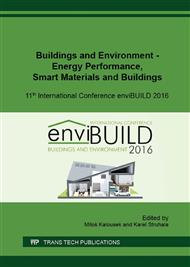p.40
p.48
p.56
p.64
p.72
p.80
p.88
p.96
p.104
Testing of Fire Retardants
Abstract:
The authors deal with the importance and significance of fire retardants for fire protection in practice. The main aim of this paper is to inform the readers about the possibilities of wood modifications by fire retardants. The authors present the experiment of testing wood specimens applying the experimental scientific method of test for limited flame spread on the test bench under laboratory conditions. The results of the experiment represent fire-technical characteristics that describe the wood behavior during the process of combustion. Different types of fire retardants are evaluated according to the selected evaluation criterion - the weight loss of test specimens. The conclusion summarizes the results of the experiment and recommendations for fire retardant modification in practice.
Info:
Periodical:
Pages:
72-79
Citation:
Online since:
December 2016
Keywords:
Price:
Сopyright:
© 2017 Trans Tech Publications Ltd. All Rights Reserved
Share:
Citation:


